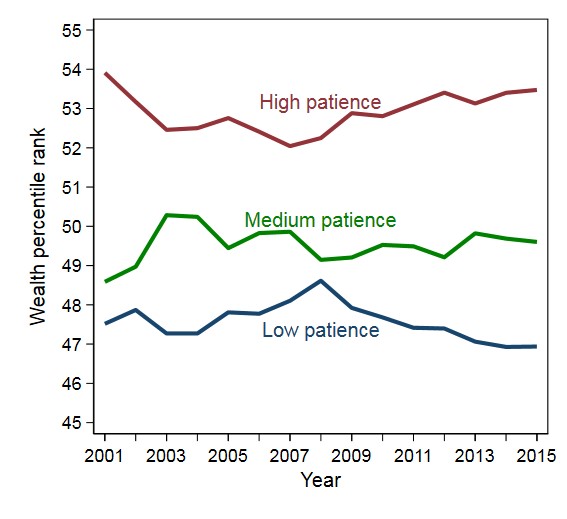Patient people are wealthier
We document a strong association between patience and wealth inequality by linking experimental data from a large preference-elicitation experiment with administrative wealth records.
Furthermore, by using historical survey measures of patience and detailed administrative data of wealth determinants, we establish a causal relationship from patience to wealth inequality, which most likely runs through differences in savings behavior in accordance with theory.
Why some people are rich while others are poor is of fundamental interest in social science and has been the focus of much public debate in recent years.
A prediction from standard savings theory is that patient individuals save more than less patient individuals and therefore become wealthier throughout the life cycle.
Rich experimental evidence – from the famous marshmallow experiments measuring delayed gratification in children in the 1960s to recent research on intertemporal choices to reveal discounting behavior of adults – points to pervasive differences of patience in people. But do these differences create wealth inequality as hypothesized by theory?
Our research answers this question by linking data from preference-elicitation experiments with high-quality administrative data for a large sample of about 3,600 mid-life Danish individuals. We use established incentivized experimental elicitation methods to measure patience and other behavioral parameters. The Danish administrative data provides information about individuals’ real-life wealth and income over the life cycle as well as detailed background information relevant for understanding wealth formation.
We document a strong association between individuals’ discounting of the future and their position in the real-life wealth distribution. This is illustrated in the figure below, which plots the average percentile rank in the wealth distribution for three groups of individuals with different levels of patience. The figure shows that the most patient individuals are, on average, positioned 6-7 percentiles higher in the wealth distribution than the least patient individuals are, and that the medium patient individuals are positioned, on average, in between the two other groups in the wealth distribution.
The association is stable over time as seen in the figure and it is of the same magnitude as the association between wealth inequality and education. Education is known to be one of the best predictors of inequality.
The association between patience and wealth inequality also exists when using a survey-based patience measure elicited three decades ago at age twenty, and it remains strong after controlling for education, income profile, school grades, initial wealth, parental wealth, credit constraints, demographics, risk preferences and additional behavioral parameters.
The results suggest a causal mechanism from patience to wealth inequality running through differences in savings levels in accordance with savings theory.

References
Epper, Thomas, Ernst Fehr, Helga Fehr-Duda, Claus Thustrup Kreiner, David Dreyer Lassen, Søren Leth-Petersen and Gregers Nytoft Rasmussen (2019). “Discounting Behavior and Wealth Inequality.” CEBI working paper 08/19. Forthcoming in the American Economic Review. You can read the paper here
